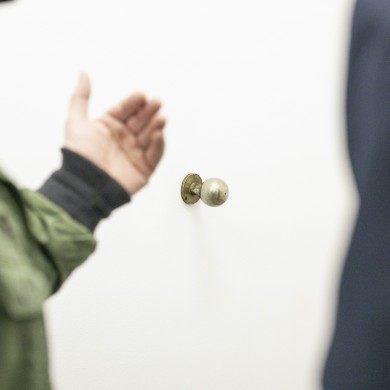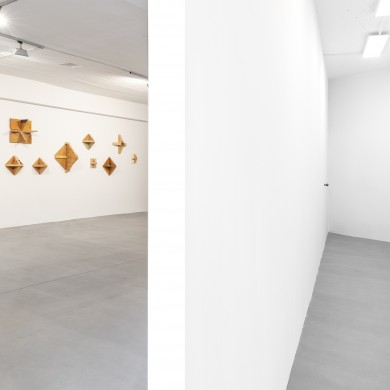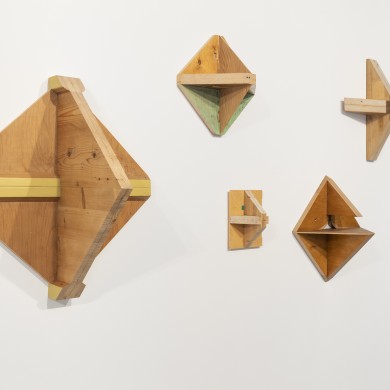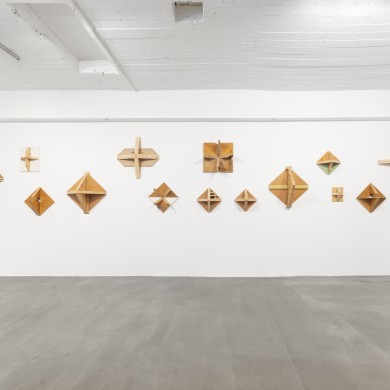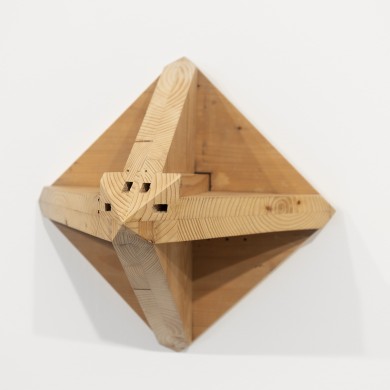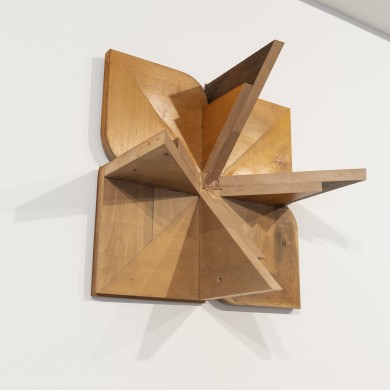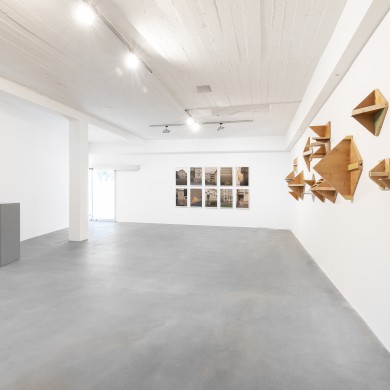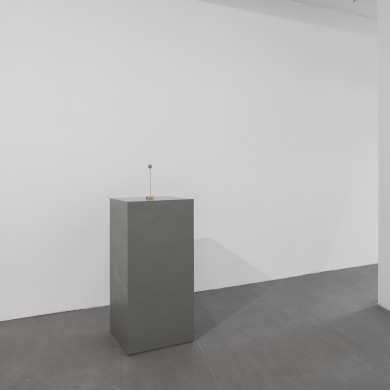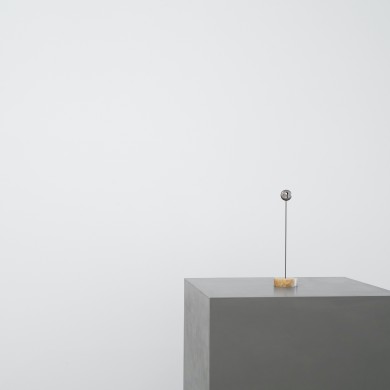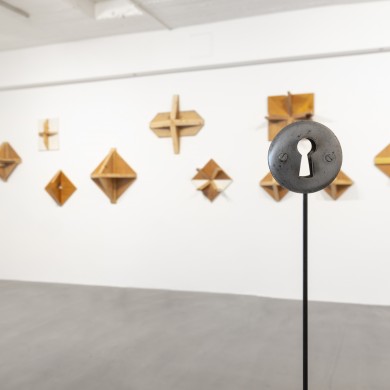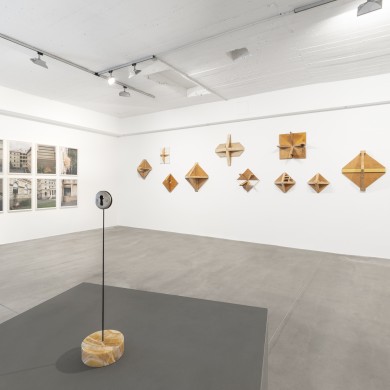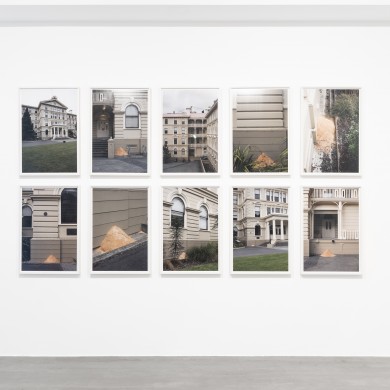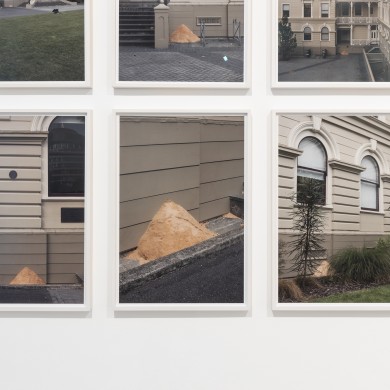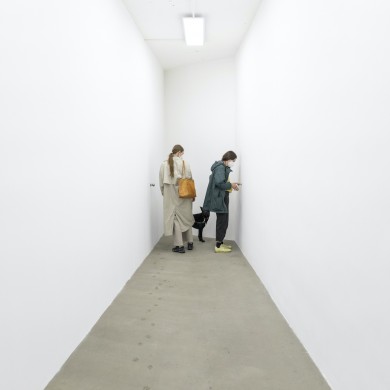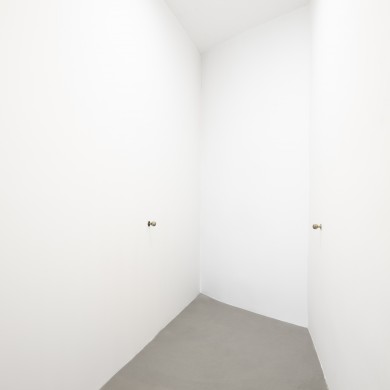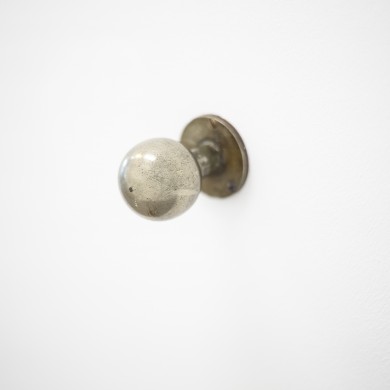Roman Ondak
| Camouflage
19 May – 15 July 2021
ZAHORIAN & VAN ESPEN Bratislava
An artist with good instinct, Roman Ondak has an exquisite talent for observing ordinary things. And especially the relationships between them and us, which by conceptual thinking he manages to transform to something uncommon, while at the same time not masking their triviality. In his sculptures, objects and installations a wardrobe, a floor, a wall, a door, a keyhole, a handle, a table – predominantly things of the interior, metaphorically internal, inward things – nonetheless remain those same real objects that we know from everyday life. From the mid-1990s to the present, Ondak has been using this stable repertoire of ready mades and fragments of them (whose origin, if the situation demands it, he will declare in the title). It might seem that this concept must have an air of tedious routine by now, an artist’s “safe bet”, but the contrary is true: it has energy, vitality and meaningful circulation. The concept testifies to the artist’s intense concentration and does not only function “on first encounter”; years on, it still carries a certain evolutionary potential. Its “matter-of-fact” expression speaks a universal language, interpretively charged and open to several possible decodings. I must acknowledge that, refined and sophisticated as it is, it can torment the intellect. The main reproach against modern and contemporary art is that it is monological; Ondak comprehensively negates this, not just by his simple, humanly close objects, but also by the fact that his works are naturally dialogic. Right from the beginning he is counting on the viewer/viewers, as he plays with perception, thought-stereotypes, conventions, boundaries, restrictions and taboos.
In ZAHORIAN & VAN ESPEN Ondak presents a selection of older and new works, based exclusively on sculpture. From the minimal, almost invisible and easy-to-miss, to those bulkier ones that destabilise eyes and mind by their rational geometry, optical qualities, logic and modernist aesthetics. They are based on things turned to perspectives unfamiliar but existing immanently in the whole, concealed behind a cloak or inwardly present. According to Roman Ondak, Camouflage is about the perception of reality and the capacity of art to communicate reality. Is the fiction of art different from that fiction which we sometimes, living our lives, take in exchange for reality? We find a direct reference in the documentation of his one-day intervention Camouflaged Building (2009), where he wittily, playfully and subtly uncovered the real inner essence of old government buildings in Wellington (New Zealand). In Walls Being Doors (installation, 2012) and Two Keyholes Facing Each Other (object, 2012) he applied the strategy of erasing relatively large sections substituted only by details. There was a symbolic opening of empty passages in the first case; the opening of all passages in the second case conveyed the sculptor’s homage to total transparency and the end of voyeurism, while paradoxically at the same time resting on the dubious foundation of a luxurious onyx plinth. In a new series of hung objects Crosses and Pyramids (2019-2020) Ondak shows how well he understands “his” objects, transforming their original form into signs, shapes, symbols, rebuses, and visual codes. At first glance we are no longer able to identify the old, familiar, good, safe thing. Out of fragments of the support system of the inward object, the artist disinters other meanings and highlights the fact that the first glance is simply never enough. With his gradual revealing of layers, Ondak is doing sculptorly work in a traditional sense: removing matter and becoming conscious that those difficult things which baffle us can be apprehended from a number of perspectives: overturned, turned about, erased, fragmented, stripped bare, turned inside out. In both the literal and metaphorical senses he is interested in what goes on beneath the surface, in the core, behind a cloak or a mask. His sculptorly, spatial thinking proceeds from the bonds between something and someone. It is defined by several possibilities of looking at the physical and mental frameworks, entangled as they are in further paradoxes, contrasts, and ironic questions and exclamation marks that are opening up. / Vladimíra Büngerová
Roman Ondak studied painting at the Academy of Fine Arts in Bratislava from 1988 to 1994. He also studied at Slippery Rock University, Pennsylvania (1993) and had residencies at BINZ39, Zurich (1994-95), Collegium Helveticum in Zurich (1999–2000); the CCA in Kitakyushu (2004); he has had grants from the DAAD in Berlin (2007/08) and the Villa Arson in Nice (2010).
In 2012 he was awarded the Artist of the Year prize by Deutsche Bank and in 2018 won the Lovis Corinth Prize, Kunstforum Ostdeutsche Galerie Regensburg.
His solo exhibitions include projects :
SK Parking, Kunsthalle Bratislava (2021); Time Capsule, Slovak National Gallery, The Schaubmar Mill, Pezinok (2020); Based on True Events, Lovis-Corinth-Preis,Kunstforum Osdeutsche Galerie Regensburg, Germany (2018); History Repeats Itself, Kunsten Museum of Modern Art in Aalborg, Denmark (2017); Sequences VIII: Elastic Hours, The Living Art Museum, Reykjavik (2017); The Source of Art is in the Life of a People, South London Gallery, London (2016); Good Feelings in Good Times – Performance, Tate Modern, London (2016); Storyboard, Guangdong Times Museum, Guangzhou, China (2015); Escena, Museo Nacional Centro de Arte Reina Sofía, Palacio de Cristal, Madrid, Spain (2013); Some Thing, The Common Guild, Glasglow, United Kingdom (2013); do not walk outside this area, Deutsche Guggenheim, Berlin, Germany (2012); Roman Ondak, Musée d’art moderne de la Ville de Paris, Paris France (2012); Within Reach of Hand or Eye, K21 Düsseldorf (2012); Time Capsule, Modern Art Oxford, Oxford (2011); Enter the Orbit, Kunsthaus Zürich, Zürich Switzerland (2011); Before Waiting Becomes Part of Your Life, Salzburger Kunstverein, Salzburg, Germany (2011); Loop, Czech and Slovak Pavilion of the 53rd Biennale di Venezia (2009), Measuring the Universe, The Museum of Modern Art, New York, United States (2009) …
Roman Ondak also exhibited at dOCUMENTA (13) Kassel, 6th Berlin Biennale, 53. Venice Biennale and 10th Gwangju Biennale.
Roman Ondak is represented by the galeries: gb agency (Paris), Martin Janda (Vienna), kurimanzutto (Mexico City, New York) and Esther Schipper (Berlin).
Supported using public funding by Slovak Arts Council ![]()
and Bratislava Self-Governing Region
Roman Ondak
| Camouflage
19. 5. – 15. 7. 2021
ZAHORIAN & VAN ESPEN Bratislava
Roman Ondak je umelcom s dobrým inštinktom a vycibrenou pozorovacou schopnosťou pre všedné veci. A hlavne pre vzťahy medzi nimi a nami, ktoré konceptuálnym myslením dokáže transformovať na neobyčajné, no zároveň ich triviálnosť až tak nemaskuje. V niektorých jeho sochách, objektoch a inštaláciách zostávajú tými istými reálnymi predmetmi, aké poznáme z každodennosti – skriňa, podlaha, stena, dvere, kľučka, kľúčová dierka, držadlo, stôl – prevažne interiérové, metaforicky interné, vnútorné veci. Tento ustálený repertoár „ready made-ov“ a ich fragmentov, ktorých pôvod, ak si to situácia žiada, dopovie názvom, Ondak využíva od polovice 90. rokov 20. storočia až po súčasnosť. A hoci by sa mohlo zdať, že tento koncept by už mohol zaváňať rutinou, nudou, autorskou „istotou“, opak je pravdou – má energiu, vitálnosť a zmysluplnú cirkuláciu. Je svedectvom intenzívnej autorskej koncentrácie a nefunguje len „na prvú“, aj po rokoch nesie istý evolučný potenciál. Jeho „vecný“ slovník hovorí univerzálnym jazykom, interpretačne nasýteným a otvoreným viacerým možnostiam dekódovania, a musím uznať, že svojou sofistikovanou rafinovanosťou vie intelekt aj pekne potrápiť. Monologickosť, hlavnú výčitku voči modernému a aj súčasnému umeniu Ondak dokonale neguje nielen jednoduchými, ľudsky blízkymi objektmi, ale i tým, že povaha jeho diel je dialogická. Od samého počiatku s divákom/divákmi počíta, pohráva sa s percepciou, stereotypmi myslenia, konvenciami, hranicami, obmedzeniami a aj zákazmi.
Roman Ondak v ZAHORIAN & VAN ESPEN prezentuje výber starších a nových diel založených výlučne na soche. Od minimálnych, takmer neviditeľných a ľahko prehliadnuteľných až po hmotnejšie, destabilizujúce zrak i myseľ racionálnou geometriou, optickými vlastnosťami, logikou a modernistickou estetikou. Ich základ tkvie vo veciach obrátených do neznámych perspektív, ale imanentne existujúcich v celku, zamaskovaných plášťom, či prítomných vo vnútri. Podľa Romana Ondaka je Camouflage o vnímaní reality a o schopnosti umenia realitu sprostredkovať. Kladie si pritom zásadnú otázku – je umelecká fikcia iná ako tá, za ktorú si v živote niekedy realitu zamieňame? Priamy odkaz nájdeme v dokumentácii jeho jednodňovej intervencie Camouflaged Building (2009), v ktorej vtipne, hravo a nenápadne poodhalil vnútornú, skutočnú podstatu starých vládnych budov vo Wellingtone (Nový Zéland). Stratégiu vymazávania väčších častí suplovaných iba detailmi uplatnil v inštalácii Walls Being Doors (2012) a objekte Two Keyholes Facing Each Other (2012). V prvom prípade symbolicky otvorením prázdnych brán a v druhom všetkých brán ako sochársku poctu totálnej transparentnosti a koncu voyerizmu, zároveň však paradoxne spochybneným ukotvením na luxusnom ónyxovom soklíku. V novej sérii závesných objektov Crosses a Pyramids (2019-2020) Ondak ukazuje ako dobre „svojim“ objektom rozumie, ich pôvodnú formu transformuje do znakov, tvarov, symbolov, rébusov a vizuálnych kódov. Na prvý pohľad už nevieme identifikovať starú, známu, dobrú a bezpečnú vec. Autor z fragmentov oporného systému interiérového predmetu vydoluje iné významy a upozorní, že jednoducho prvý pohľad nikdy nestačí. Ondak s postupným odkrývaním vrstiev pracuje v tradičnom sochárskom zmysle – odoberaním hmoty a uvedomovaním si viacerých perspektív vnímania náročných hlavolamov – prevrátených, obrátených, vymazaných, fragmentovaných a vyzlečených naruby. V doslovnom aj v prenesenom význame sa zaujíma o dianie pod povrchom, v jadre, ukrytom za plášťom alebo maskou. Jeho sochárske a priestorové myslenie vychádza z väzieb medzi niečím a niekým. Je definované viacerými možnosťami pohľadov na fyzické a mentálne rámce, zauzlené otváraním ďalších paradoxov, kontrastov a ironických otázok s výkričníkom. / Vladimíra Büngerorá
Roman Ondak študoval v rokoch 1988 – 1994 maľbu na Vysokej škole výtvarných umení v Bratislave. Študoval taktiež na Slippery Rock University, Pennsylvania (1993) a absolvoval rezidencie na BINZ39, Zürich (1994 – 95), Collegium Helveticum, Zürich (1999 – 2000), CCA v Kitakyushu (2004) a vo forme grantov ho podporili DAAD v Berlíne (2007/08) a Villa Arson v Nice (2010).
V roku 2012 dostal cenu “Umelec roka” od Deutsche Bank a v roku 2018 vyhral Lovis Corint Prize a cenu Kunstfroum Ostdeutsche Galerie Regensburg.
K jeho samostatným projektom patria výstavy:
SK Parking, Kunsthalle Bratislava (2021); Time Capsule, Slovenská národná galéria, Schaubmarov mlyn, Pezinok (2020); Based on True Events, Lovis-Corinth-Preis, Kunstforum Ostdeutsche Galerie Regensburg, Nemecko (2018); History Repears Itself, Kunsten Mmuseum of Modern Art, Aalborg, Dánsko (2017); Sequences VIII: Elastic Hours, The Living Art Museum, Reykjavík (2017); The Source of Art is the Life of People, South London Gallery, Londýn (2016); Good Feelings in Good Times – Performance, Tate Modern, Londýn (2016); Storyboard, Guangdong Times Museum, Guangzhou Čína (2015); Escena, Museu Nacional Centro de Arte Reina Sofia, Palacio de Cristal, Madrid, Spain (2013); Some Thing, The Common Guild, Glasgow, United Kingdom (2013); do not walk outside this area, Deutsche Guggenheim, Berlín, Nemecko (2012); Roman Ondak, Musée d’art moderne de la Ville de Paris, Paríž, Francúzsko (2012); Within Reach of Hand or Eye, K21 Düsseldorf (2012); Time Capsule, Modern Art Oxford, Oxford (2011), Enter the Orbit, Kunsthaus Zürich, Zürich, Švajčiarsko (2011); Before Waiting Becomes Part of Your Life, Salzburger Kunstverein, Salzburg, Rakúsko (2011); Loop, Czech and Slovak Pavilion of the 53rd Biennale di Venezia (2009) . . .
Roman Ondak vystavoval aj na dOCUMENTA (13) Kassel, 6. Berlínskom bienále, 53. Benátskom bienále a 10. Gwangju bienále.
Romana Ondaka zastupujú galérie : gb agency (Paríž), Martin Janda (Viedeň), kurimanzutto (Mexico City, New York) a Ester Schipper (Berlín).
